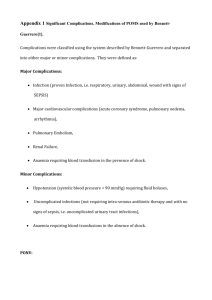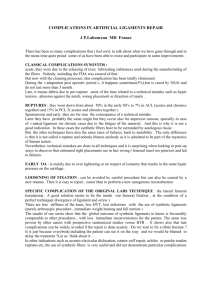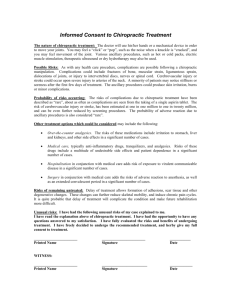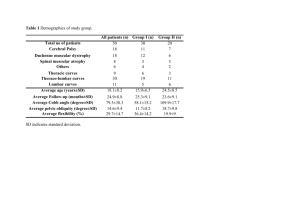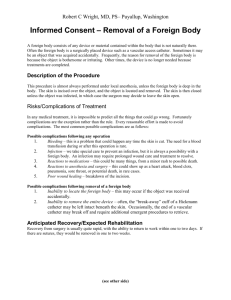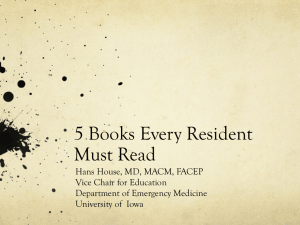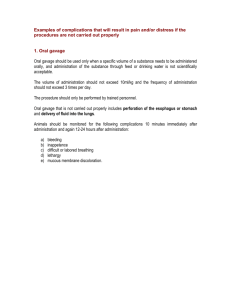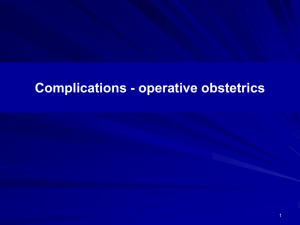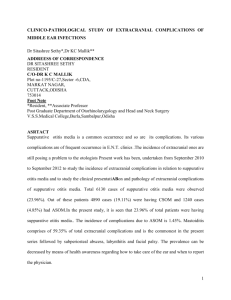1465-9921-14-50-S1
advertisement
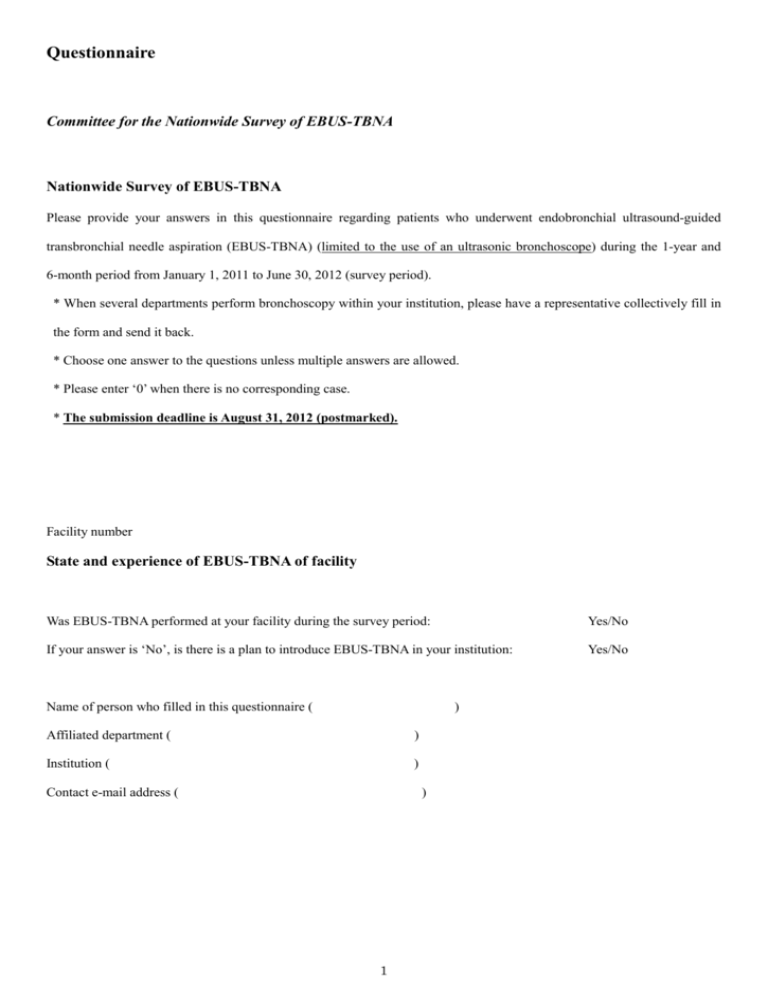
Questionnaire Committee for the Nationwide Survey of EBUS-TBNA Nationwide Survey of EBUS-TBNA Please provide your answers in this questionnaire regarding patients who underwent endobronchial ultrasound-guided transbronchial needle aspiration (EBUS-TBNA) (limited to the use of an ultrasonic bronchoscope) during the 1-year and 6-month period from January 1, 2011 to June 30, 2012 (survey period). * When several departments perform bronchoscopy within your institution, please have a representative collectively fill in the form and send it back. * Choose one answer to the questions unless multiple answers are allowed. * Please enter ‘0’ when there is no corresponding case. * The submission deadline is August 31, 2012 (postmarked). Facility number State and experience of EBUS-TBNA of facility Was EBUS-TBNA performed at your facility during the survey period: Yes/No If your answer is ‘No’, is there is a plan to introduce EBUS-TBNA in your institution: Yes/No Name of person who filled in this questionnaire ( ) Affiliated department ( ) Institution ( ) Contact e-mail address ( ) 1 Survey of the current state of EBUS-TBNA use Important notes on answering the questions Operator is defined as the physician who performed the puncture. Exclude complications assumed to be caused by procedures other than EBUS-TBNA, such as forceps biopsy and alveolar lavage. When 2 or more complications were caused by a single examination, enter those in individual columns of complications. When there is no corresponding case, enter ‘0’. Complications are defined as follows: Cf.: Hemorrhage is defined as that which required treatment other than aspiration, compression, and infusion of cold saline. Massive hemorrhage is defined as blood loss of 300 mL or more, or cases requiring blood transfusion. Regarding pneumonia and pleurisy, apparent aggravation of those present before the examination are included. Lidocaine intoxication is defined as cases which required special treatment for convulsion and loss of consciousness. Bronchial asthmatic attack is defined as cases which required treatments, such as drip infusion and tracheal intubation. Circulatory complications include unexpected hypotension, arrhythmia, angina attack, myocardial infarction, and cardiac arrest. Respiratory failure is defined as cases which required treatments, such as tracheal intubation and artificial ventilation (excluding oxygen administration). 2 Number of EBUS-TBNA applications: Total number of applications: ( ) Number of applications by objective (overlapping allowed): Staging of lung cancer: ( ) Definite diagnosis: ( ) (Choose the most likely disease) Suspected lung cancer: ( ) Suspected malignant lymphoma: ( ) Suspected sarcoidosis: ( ) Others ( ) (details: Number of applications by puncture site (overlapping allowed): Hilar/mediastinal lymph node: ( ) Lesions in the lung field: ( ) Number of applications by operator Performed by JSRE-accredited non-fellows: ( ) Performed by JSRE-accredited fellows: ( ) 3 ) Number of complications Total number of complications: ( ) Number of each complication (overlapping allowed): Hemorrhage: ( ) Massive hemorrhage in the above cases: ( ) Pneumonia: ( ) Pleurisy: ( ) Mediastinitis: ( ) Pericarditis: ( ) Sepsis: ( ) Other infectious complications ( ) (details: Pneumothorax: ( ) ) Cases which required tube drainage in the above: ( ) Lidocaine intoxication: ( ) Bronchial asthmatic attack: ( ) Circulatory complications: ( ) (details: Respiratory failure: ( ) Others: ( ) (details: ) ) Did you encounter damage to an ultrasound bronchoscope and peripheral instruments during the survey period? Number of damaged instruments: Damage of ultrasound bronchoscope: ( ) Damage of working channels, such as perforation by a needle: ( ) Damage of the fiber region by external compression, such as biting by the patient: Damage of the ultrasound probe region: ( ) Other damage: ( ) (details: Damage of puncture needle: ( ) 4 ( ) ) Yes/No Case report of complications Case number ( ) Patient background 1. Sex: male/female 2. Age: ( ) years old 3. Concomitant disease (multiple answers allowed): lung cancer, pulmonary emphysema, bronchial asthma, chronic heart disease, hypertension, arrhythmia, renal failure, diabetes, others ( ) 4. When bronchial asthma is concomitantly present, is pretreatment with a bronchodilator administered: yes/no 5. State of medication with antiplatelet agents and anticoagulants: being treated, withdrawn, not previously medicated 6. Puncture site: hilar mediastinal lymph node, lesions in the lung field Background of operator 1. JSRE-accredited fellow: yes/no 2. Number of EBUS-TBNA applications performed before the occurrence of complications: fewer than 5, 5-19, 20-49, 50 or more 3. Participation in hands-on training: yes/no Test conditions 1. Intravenous sedation: with/without 2. Gauge of needle: 22, 21 3. Number of lymph nodes punctured: 1, 2, 3, 4 or more 4. The maximum short axis of lymph nodes punctured: less than 5 mm, 5-10 mm, larger than 10 mm 5. Punctured site: 1, 2R, 2L, 4R, 4L, 7, 10R, 10L, 11R, 11L, others ( ) 6. Echo finding(s) of the punctured site: necrosis was suspected, a cyst was suspected, other regions, unclear 7. Total frequency of punctures: 1, 2, 3, 4, 5 or more 8. On-site cytology: performed/not performed 9. Preventive antibiotic treatment: performed/not performed Test results 5 1. Possibility of making a diagnosis based on EBUS-TBNA findings: possible/not possible 2. Final diagnosis: lung cancer (non-small cell carcinoma, small cell carcinoma, unclear), metastatic lung tumor, malignant lymphoma, other malignancies, sarcoidosis, other benign diseases, indeterminate Complication 1. Types of complication: hemorrhage (massive hemorrhage), pneumonia, pleurisy, mediastinitis, pericarditis, sepsis, other infectious complications (details: ), pneumothorax, lidocaine intoxication, bronchial asthmatic attack, circulatory complications (unexpected hypotension, arrhythmia, angina attack, myocardial infarction, and cardiac arrest), respiratory failure, others (details: ) Treatment: tube drainage, tracheal intubation, others ( ) Outline of complications (concretely describe the complications that occurred, applied treatment, and the suspected cause to supplement the above). 2. Adverse events resulting from complications: none in particular, prolongation of hospitalization, treatment to prevent permanent disorder, life-threatening condition, physical disorder, death 6
